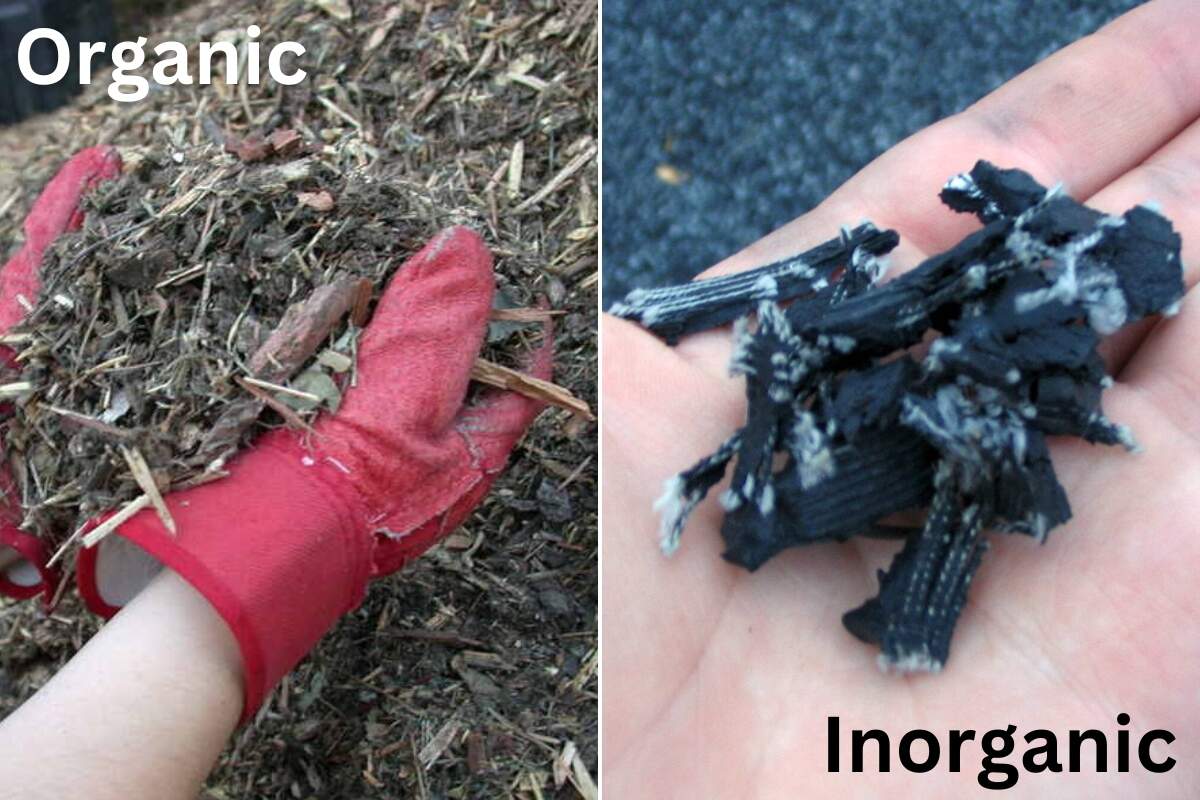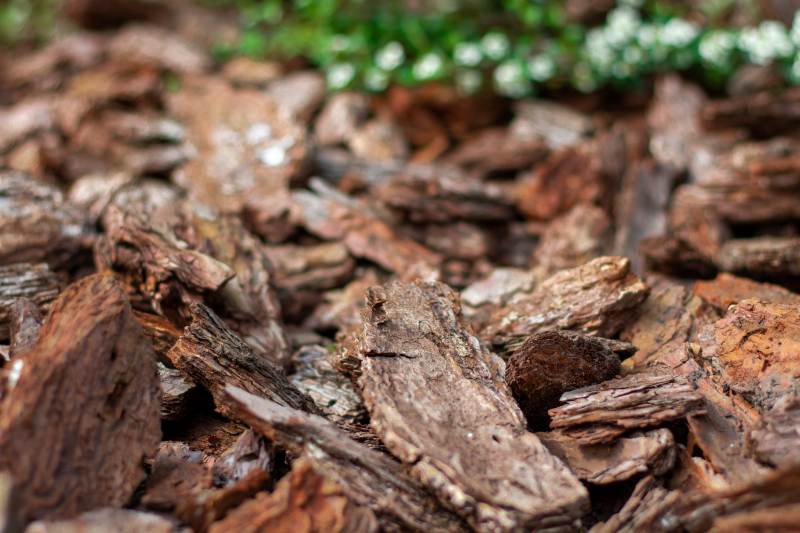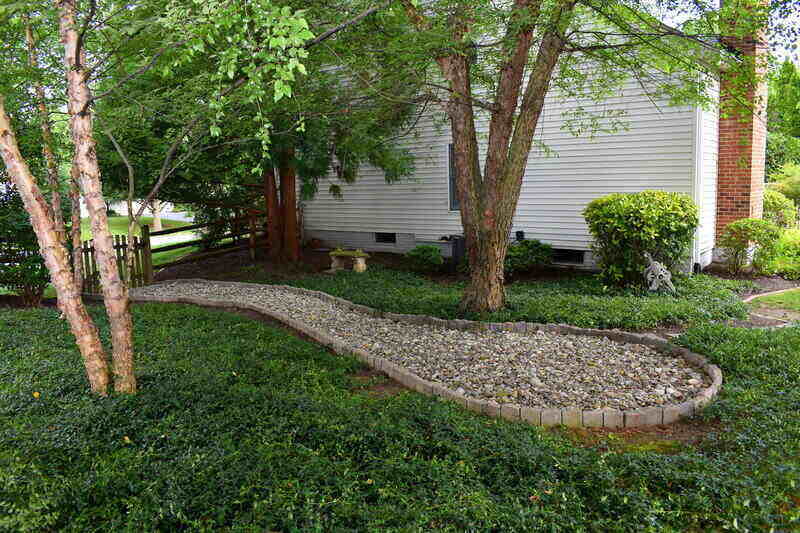
The difference between organic and inorganic mulch extends far beyond mere aesthetics. Organic mulch can nurture your garden’s health and vitality. Meanwhile, inorganic mulch requires little to no maintenance.
Organic mulches retain moisture and improve soil quality, while their inorganic counterparts are durable and aesthetically appealing. Yet, each also has its quirks.
“Some organic mulches can harbor invasive or destructive insects, rodents, plants, or fungi,” says Allison Bailey, agriculture and natural resources agent at the University of Georgia. “Some inorganic mulches like plastic sheeting can hinder water infiltration and root aeration.”
Differences Between Organic and Inorganic Mulch
Both organic and inorganic mulches share common benefits for the soil, such as regulating soil temperature, conserving water, and suppressing weeds. However, some differences set them apart. For example, organic mulches decompose and enrich the soil, while inorganic are more durable and require less replacement.
If you need help obtaining and spreading mulch, LawnStarter can connect you with a lawn care professional near you.
Organic mulch is made from natural materials that break down over time. Some examples are:
- Grass clippings
- Bark
- Wood chips
- Leaves
- Straw
- Compost
- Pine needles
- Cocoa hulls
Inorganic mulch is a low-maintenance option made from non-plant materials. Unlike their organic counterparts, they do not decompose. Some examples include:
- Rocks
- Stones
- Landscape fabric
- Rubber mulch
- Gravel
- Plastic sheeting
It’s important to remember that not all organic mulches have the same advantages. Pine needles, and straw, for instance, have greater erosion control properties than other organic mulches. With that in mind, the chart below demonstrates a brief summary of the basic differences between most organic and inorganic mulch types.
| ORGANIC MULCH | INORGANIC MULCH | |
| Soil Health | Enriches soil by breaking down and adding nutrients. | Does not add nutrients to the soil. |
| Durability | Must be replaced annually. | Degrades slowly, if at all. |
| Moisture Retention | Organic mulches conserve soil moisture by creating a protective barrier on the soil surface. | Inorganic mulches, such as rocks, can’t conserve moisture. But others, like plastic, can conserve moisture by slowing evaporation. |
| Weed Control | Most options are good at preventing weeds. However, some mulches, like straw or grass clippings, can contain weed seeds that later germinate. | Good at weed control, although weeds can appear between rocks. |
| Cost | Generally affordable, but the cost can add up with annual replacement. | Has a higher up-front cost but is long-lasting. |
| Erosion | Prevents soil from washing away during rainstorms, making it ideal for sloped areas. | Protects against soil erosion, but it can also prevent proper water infiltration and limit aeration. |
| Insulation | During cold or hot weather, organic mulch gives the soil an insulated layer of protection. | Inorganic mulch can cause the soil to overheat in extreme temperatures and provides moderate insulation. |
Read More: Mulch Guide: Types, Pro Tips and Where to Mulch
Soil Health
When it comes to soil health, organic mulch provides your garden with a big meal. As it decomposes, it adds nutrients to the soil and increases its fertility.
“As it decomposes, organic mulch adds nutrients (organic matter), enhances soil structure, and supports beneficial microorganisms,” says Bailey.
On the other hand, inorganic mulch is like an empty plate. It doesn’t offer nutritional value to your soil. In fact, some inorganic mulch, such as landscape fabric, is bad for your soil because it suffocates worms.
Read More: How to Improve Your Lawn With Mulch
Durability
Organic mulch needs to be replaced every one or two years because it breaks down over time and disappears into the soil.
In contrast, inorganic mulches such as rocks, gravel, or landscape fabric generally need to be replaced every 10 to 20 years or when they become faded, compacted, or displaced. However, it is important to note that certain inorganic mulch materials, like gravel or fabric, can be difficult to move or replace once installed.
Read More: How Often Should You Replace Mulch
Moisture Retention

Photo Credit: Andrii Chagovets / Adobe Stock / License
Organic mulch conserves moisture naturally, reducing the need for frequent watering. In hot, dry climates, organic mulch is ideal for retaining soil moisture and keeping roots cool. However, in cooler, wetter regions, Bailey says it can hold too much moisture, increasing the risk of fungal diseases.
In contrast, inorganic mulch can be inconsistent. For instance, rocks allow moisture to evaporate. However, if you choose plastic, it will reduce evaporation, helping to retain moisture. In areas with heavy rainfall, Bailey recommends using inorganic mulches like stones or other loosely packed materials, as they offer improved drainage
Weed Control
Weed control is where organic and inorganic mulch shine. Organic mulch “suppresses weeds naturally,” Bailey says, and “creates a barrier that inhibits weed seeds from germinating.” However, be careful with pine straw or grass clippings, as they can contain seeds and surprise you with a new batch of weeds.
Inorganic mulch effectively blocks weeds, and materials like landscape fabric are highly efficient. However, weeds can still emerge between materials such as rocks. When using stones, I recommend selecting options smaller than half an inch for improved water conservation and weed management
Cost
When starting from scratch, organic mulch is the cheaper option ranging from $20 to $110 per cubic yard. However, because it needs regular replenishment, the cost can sneak up on you over time. Inorganic mulch demands more cash upfront — generally ranging from $50 to $400 per cubic yard — but rewards you with its durability.
The average price of mulch per cubic yard generally falls between $192 to $402, including materials and labor. Additionally, there are opportunities to obtain mulch for free through tree care services, composting, or natural materials, such as grass clippings, leaves, pine needles, or straw, if they’re available in your area.
Erosion

For erosion control, organic mulch acts like a natural barrier, preventing soil from washing away during rainstorms and making it perfect for sloped areas. It holds the soil in place while it breaks down.
Inorganic mulch, on the other hand, creates a sturdy layer that protects against soil erosion, but it can also prevent proper water infiltration and limit root aeration.
Read More: How Deep Should Mulch Be?
Insulation
Organic mulch excels in providing natural insulation to your lawn’s soil and keeps it protected from extreme temperatures. Inorganic mulch can help moderate soil temperature, but it can cause issues in extreme heat.
“Some materials (e.g., black plastic, rubber mulch) absorb heat, raising soil temperature and stressing plants,” Bailey warns.
Read More: Pros and Cons of Rubber Mulch in Your Landscaping
Organic and Inorganic Mulch: Which is Best For You?
Choosing the right mulch for your garden depends on factors such as climate, soil type, the plants you’re growing, and even the aesthetic you wish to create. By considering these elements, you can select a mulch that enhances your garden’s health and complements its overall design.
Climate
- If you live in a hot and dry climate, organic mulch helps retain moisture, reduces evaporation, and keeps plant roots cool. “Inorganic mulch can be helpful for xeriscaping, but materials like black plastic or rubber can make the soil too hot,” Bailey says.
- In cool and moist climates, organic mulch provides insulation and stabilizes soil temperature. However, because it holds moisture, Bailey says it can increase the risk of fungal diseases. Inorganic mulch is a better choice if you need to control excess moisture.
Soil Type
- Sandy soil drains quickly, so organic mulch is ideal. It helps retain moisture and adds organic matter to improve soil structure. Inorganic mulch doesn’t offer these benefits and may make the soil even drier.
- Clay soil is heavy soil and can hold too much water, Bailey explains. Organic mulch helps break it up, improving drainage and aeration. In contrast, inorganic mulch can lead to water pooling on the surface.
- Loamy soil, being naturally rich and balanced, works well with either type of mulch, depending on your plants’ needs.
Plants
- If you’re growing vegetables and annuals, inorganic mulch is the best choice. As it breaks down, it provides essential nutrients for these short-lived plants.
- Perennials, shrubs, and trees benefit from organic mulch, which improves soil health over time.
- For drought-tolerant plants and succulents, inorganic mulch is the better option. “Inorganic mulch, such as gravel or rocks, is better because it prevents excess moisture and mimics the plant’s natural habitat,” Bailey says.
Design Aesthetics
Your mulch choice not only supports your plants but also reflects your style and the atmosphere you want to create in your garden. Below, I’ve outlined my favorite aesthetic styles and the mulch options to match them.
- Minimalist and modern: Opt for inorganic mulch like rocks or gravel. ”Decorative stones or rubber mulch can create a clean, polished look,” suggests Bailey.
- Cozy and rustic: Choose bark chips, shredded wood, or cocoa hulls to create a warm, natural garden.
- Lush and tropical: Use dark-colored organic mulch like pine bark or compost to enhance greenery.
- Desert and drought tolerant: Pea gravel or sand works well for xeriscaping, which requires little to no water while giving a southwestern vibe.
- Playful and whimsical: Try colored rubber mulch or bright wood chips in garden beds or play areas for a fun, creative touch.
FAQ About Organic and Inorganic Mulch
The best time to put down mulch is mid to late spring because the soil needs time to warm up after winter. Mulching too early can slow the warming process that helps plants to grow.
There’s no need to remove old organic mulch. As it naturally decomposes over time, it enriches the soil with essential nutrients and organic matter. However, removing inorganic mulch, especially stones and gravel, can be challenging if you want to replace it with organic mulch.
Yes, mulching around trees is a great idea. It recreates the natural environment of a forest floor, helping to support the tree’s health and protect its root system.
Read More: How to Mulch Around Trees
Find a Lawn Care Pro Near You
When choosing between organic and inorganic mulch, remember that each offers its own benefits for your outdoor space. For example, organic mulch enriches the soil as it decomposes, while inorganic mulch is durable and requires little to no replacement.
While choosing the best type of mulch for your lawn is easy, spreading it can be difficult. LawnStarter can connect you with a local lawn care professional who can make installation easy.
Main Image Credits:
Organic Mulch: Dvortygirl / Wikimedia Commons / CC BY-SA 3.0
Inorganic Mulch: Phasmatisnox at English Wikipedia / Wikimedia Commons / CC BY 3.0 created using Canva Pro